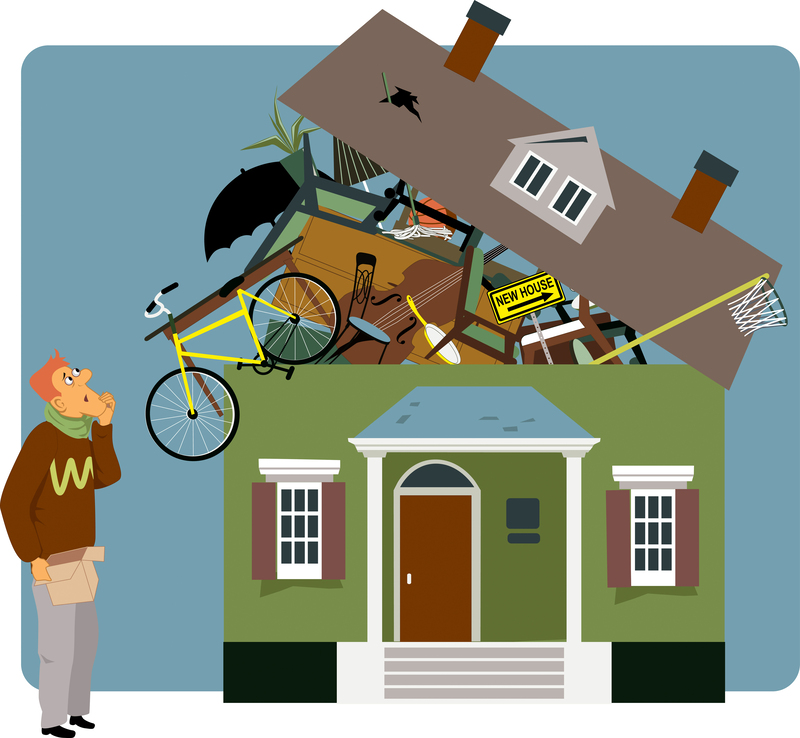Masterful Packing Techniques for a Hassle-Free Move
Posted on 19/06/2025
Masterful Packing Techniques for a Hassle-Free Move
Moving to a new home can feel overwhelming, but with expert packing methods, even the most intimidating relocation becomes manageable. If you're searching for pro packing strategies for a stress-free move, you're in the right place. This comprehensive guide covers every aspect of smart packing for moving, ensuring your belongings arrive safely and efficiently, and your entire relocation experience is as smooth as possible. Read on to learn masterful packing techniques that will transform your next move!

Why Masterful Packing Matters in Any Move
Many people underestimate the value of organized packing until moving day arrives. Using advanced packing tips for moving not only protects your cherished items but also saves time and effort during unpacking and setting up your new home. Here's why investing time in perfect packing solutions is non-negotiable:
- Reduces stress by creating clarity and order.
- Prevents damage to valuable possessions.
- Saves money on materials and potential replacements.
- Speeds up both the move and the settling-in process.
- Improves efficiency when loading and unloading the moving truck.
Essential Packing Supplies You Need
Before diving into pro-level packing, it's crucial to have the right materials at your disposal. Quality supplies provide the foundation for top-tier packing techniques for moving. Gather the following:
- Sturdy moving boxes in various sizes
- Bubble wrap and packing paper for cushioning
- Plastic wrap and stretch wrap for securing furniture
- Strong packing tape and a tape gun
- Permanent markers and color-coded labels for organization
- Scissors or box cutters
- Specialty containers for fragile items (like dish packs or wardrobe boxes)
- Resealable plastic bags for small parts or hardware
- Furniture blankets or moving pads
Tip: Begin collecting boxes weeks in advance, and check local stores for free ones.
Step-by-Step: Expert Moving and Packing Strategies
1. Declutter Before You Pack
The first of all professional packing techniques for moving is to declutter every room. The less you own, the less you have to move. Sort items into these categories:
- Keep: Essentials and cherished possessions
- Donate: Gently used items you no longer need
- Sell: Valuables that someone else may want
- Dispose: Broken or expired goods
This process not only lightens your load but also helps you start fresh in your new home. Decluttering now means less stress on moving day and an easier transition when unpacking.
2. Create a Comprehensive Moving Checklist
One hallmark of masterful packing is preparation. Maintain a moving binder or digital spreadsheet with the following:
- Room-by-room packing lists
- Inventory of valuable and fragile items
- Essential contact information
- Moving company details
- Utilities and address change checklist
A well-organized move sets the stage for hassle-free relocation and minimizes confusion along the way.
3. Set Up a Packing Station
Dedicate an area in your home as your packing command center. This keeps materials handy, provides a place for packed boxes, and helps maintain efficiency. Here's what your packing station should include:
- Supplies (boxes, tape, markers, labels, wrapping)
- Scissors/box cutter for easy access
- A table or surface for wrapping and assembling
- Designated space for completed boxes
4. Pack One Room at a Time
For orderly moving and packing, tackle one area per session. Clearly label each box with the room, contents, and any special instructions (such as "Fragile" or "Open First"). This makes unpacking systematic and efficient at your destination.
5. Use the Right Box Sizes and Packing Combinations
Use small boxes for heavy items like books, and large boxes for lighter bulky items like linens. Mixing item types in the same box can lead to breakage or make boxes awkward to transport. Remember:
- Pack heavier items at the bottom and lighter ones on top
- Never leave empty spaces; fill gaps with paper or clothing for support
- Don't over-pack or underfill, as this can damage the box during lifting
6. Masterful Wrapping Techniques for Fragile Items
Wrap fragile items individually. Use packing paper or bubble wrap and avoid using newspaper, as ink can transfer. Plates should be packed vertically, like records, and glassware should be stuffed with paper then wrapped. When you use dish pack boxes or customized inserts, you're taking professional packing to the next level!
7. Labeling for Effortless Unpacking
Labeling is key to a stress-free move. Embrace color-coding, large bold writing, and detailed descriptions on each box. On two sides of each box, note:
- Room destination (e.g., Master Bedroom, Kitchen)
- General or specific contents (e.g., Shoes, Dishes, Bedding)
- Handling instructions ("Fragile", "Heavy", "This Side Up")
- If it's a priority box to be opened first
Pro Tip: Create a master legend for colors/labels and add them to your moving checklist.
8. Special Care for Valuables, Electronics, and Documents
Valuables, critical paperwork, and delicate electronics require masterful moving techniques:
- Transport jewelry and important documents personally.
- Back up computers in advance and use original boxes whenever possible.
- Label and bag cords, screws, and remote controls together for each device.
- Take photos of wiring setups for easy reassembly.
9. Efficient Packing Tricks for Clothes and Shoes
No need to remove clothing from hangers! Use wardrobe boxes to move garments easily. Alternatively, group hangers and wrap with large garbage bags or sheets. For shoes, stuff with socks or tissue paper to retain shape, then pack in shoe boxes or containers. This technique saves time both when packing and unpacking.
10. Furniture Protection and Disassembly
For furniture, disassemble what you can--such as bed frames and tables. Keep hardware secured in labeled bags. Protect surfaces with blankets or stretch wrap. If you're moving artwork or mirrors, use custom boxes with plenty of padding, and mark them as "Fragile."
Advanced Packing Methods for an Organized Move
Start Early and Set a Packing Timeline
Proven packing experts suggest starting weeks ahead. Establish a packing schedule that includes:
- Non-essentials (seasonal decor, books, extra linens) first
- Infrequently used rooms and items next
- Essentials (kitchenware, daily clothes, toiletries) last
This timeline ensures you're never without daily basics and minimizes last-minute stress.
Utilize Everything Quickly With the Essentials Box
Pack a first-night essentials box for each family member with:
- Medications and toiletries
- Clean clothes and pajamas
- Chargers and electronics
- Snacks and bottled water
- Basic kitchen items (coffee maker, mugs, plates)
- Important documents and keys
Having these at your fingertips will make your first night in the new home comfortable, even if the rest is still boxed up.
Utilize Rolling Suitcases for Heavy Items
Books, tools, and bulky items can be difficult to carry. Load these into rolling suitcases for easy transport and save your back the strain!
Leverage Technology for Packing Mastery
Use smartphone apps to inventory your boxes or take photos of box contents before sealing. This visual archive makes it easy to track individual items and helps if something goes missing.
Sustainable and Eco-Friendly Packing Solutions
For an eco-conscious move, use:
- Reusable plastic bins and containers
- Old towels and blankets for padding
- Recycled or donated boxes from local businesses
- Biodegradable packing peanuts or paper
These methods reduce waste and your move's environmental footprint.
Packing Mistakes to Avoid for a Smooth Move
- Procrastinating and packing too close to moving day
- Underestimating the number of boxes needed
- Mixing items from different rooms in one box
- Leaving empty space in boxes, leading to shifting and damage
- Forgetting to label boxes clearly and on multiple sides
- Neglecting to protect furniture and fragile items
- Packing hazardous or prohibited materials
Unpacking: Masterful Techniques for Settling In Fast
Sort Priority Boxes and Rooms
Begin with essential rooms such as the kitchen, bedrooms, and bathrooms. Having these functional helps you get back to normal quickly.
Check for Damage Immediately
Inspect your boxes and larger items as you unpack. If anything is damaged, take photos, and notify your moving company as soon as possible.
Organize as You Unpack
Instead of dumping contents in every room, put items away as you go. This creates a sense of accomplishment and reduces clutter.

FAQs About Packing Techniques for Moving
-
Q: How early should I begin packing for a move?
A: Start at least 4-6 weeks ahead, focusing on non-essentials and working toward daily items last. -
Q: Is it worth hiring professional packers?
A: If you're short on time, have fragile or valuable items, or want expert packing, professionals can save a lot of hassle. -
Q: What boxes are best for fragile items?
A: Use double-walled dish packs or specialty boxes designed for glassware and artwork. -
Q: Should I empty drawers or leave clothes inside?
A: Light clothing can stay in drawers if the furniture is sturdy and light; otherwise, empty drawers to prevent damage.
Conclusion: Master Your Next Move With Pro Packing Strategies
Adopting masterful packing techniques for a hassle-free move makes all the difference. By staying organized, using the right tools, packing with care, and avoiding common mistakes, you set yourself up for success. Whether you're relocating across town or moving cross-country, these methods ensure your belongings arrive safely, and you enjoy a seamless, stress-free transition to your new home.
Ready to make your next move the easiest yet? Start using these expert packing solutions today, and discover just how smooth and efficient relocation can be!



